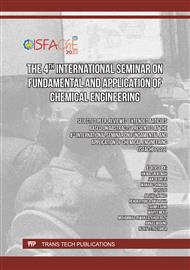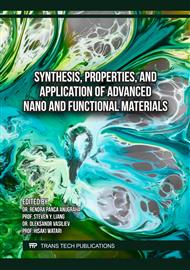[1]
M.S.N.M. Sutikno1*, "Effect of Cellulase Enzyme Concentration, α–Amylase and Glucoamylase on The Sugar Content of Cassava Reduction Skin," Journal of Industrial Technology &Agricultural Products, vol. 21, no. 1, pp.1-12, 2016.
Google Scholar
[2]
V. Gupta, "Development of the Use of Casein Products in Food Products. In: Technological Advances in the Utilization of Dairy Byproducts.," National Dairy Research Institute, vol. 60, pp.1-9, 2008.
Google Scholar
[3]
Z. B. Fang, "Comparing the efficiency of proteins and maltodextrins on spray drying of bayberry juice.," Food Res.Int, vol. 48, pp.478-483, 2012.
DOI: 10.1016/j.foodres.2012.05.025
Google Scholar
[4]
L. Hobbs, "Sweeteners from starch: production, properties, and uses," in Starch: Cistry and Technology, Elsevier, 2009, pp.797-832.
DOI: 10.1016/b978-0-12-746275-2.00021-5
Google Scholar
[5]
H.M.N.F. T Tensiska, "Production and Characterization of Maltodextrin from Corn Starch by Enzymatic Hydrolysis Method," ResearchGate, Bandung, 2018.
Google Scholar
[6]
E.N. Dewi, "Extraction of Starch from Cassava Bark Tapioca Waste by Sonication Pretreatment and Alkaline Method," Surabaya, 2017.
Google Scholar
[7]
Richana, Nur "Optimization of Maltodextrin and Tapioca Production Processes Using Spray Dryer" in Proceedings of the National Seminar on Postharvest Innovative Technology for the Development of Agricultural-Based Industries, Bandung, 2015.
Google Scholar
[8]
Jiangnan,University, "Methods for producing high-quality maltodextrin", patent from the United States No: US11142781B2, 2021.
Google Scholar
[9]
Henan Xingfa Biological Technology Co. Ltd., "Process for producing low-density malto dextrin", patent from China No: CN101429534A, 2007.
Google Scholar
[10]
Timmerhaus, Klaus. D. , (1991), "Plant Design and Economics for Chemical Engineering." Fourth Edition, pages: 542, McGraw-Hill, Inc . : New York.
Google Scholar
[11]
Brownell, and young. (1959). "Process Equipment Design". Pages 254 and 90. John Wiley and Son, Inc: Michigan.
Google Scholar
[12]
Haloho, Dikwanto. "Performance of Designing a Liquid Mixer Machine with a capacity of 40 Liters / Process", Medan University Area, 2018.
Google Scholar
[13]
. S.S. P. 2. ,. M.T. 3.,. S.M. 4. M.K. 5.,. V.M. 1.a. A.V.R. 6.*., "The Functionality and Application of Starch-Based Films: An Environmentally Friendly Approach," Foods, vol. 10, pp.1-24, 2021.
Google Scholar



